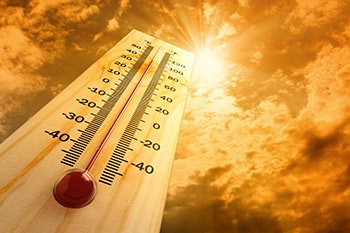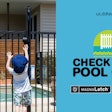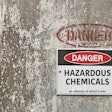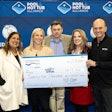
As a lifelong Arizonian, Michael Rodarte is used to the heat of the Southwest. But when he left a career in finance for a fresh start as co-founder of Classic Pool Service, he found himself a bit surprised by how hot it can really get outside the confines of an air-conditioned office.
“There’s a difference between being outside and relaxing and being outside doing work all day. So it was a big change for sure,” he says.
It’s not just rookies who are challenged by the heat of service work in southern climes. Rich Tarricone is the owner of Aquatic Pool Systems, Sarasota, Fla., and winner of the 2011 Pleatco Perfect Pool Guy award. Tarricone has been doing service work for 30 years, but that doesn’t mean he’s comfortable on a sultry Florida afternoon.
“Our humidity is tough. When it’s 96 degrees and 90 percent humidity, it’s brutal,” he says. “I remember one time, a guy had just bought a house and pool and it needed a bunch of new equipment: filter, salt system and a new timer box put on the wall. It took me about three and a half hours in the sun. I’m just working away like a bumblebee, and I look up — it’s two in the afternoon and I’m just soaked. And I hadn’t left the same 10 square feet the whole time.”
The life of a service technician has many benefits, and spending time outdoors is often cited as one of them. But for pool technicians in the South and Southwest, where temperatures regularly hit three digits, working in the sun for hours on end is not only unpleasant, but also potentially dangerous.
Here, two service pros share their advice for keeping safe on the job.
In the Truck
In keeping cool, the greatest invention in the history of summer — air conditioning — is a must for the service pro who wants to survive; but in addition to AC, Terricone keeps a portable fan in the truck for extra cooling.
“They sell these 9- and 12-inch fans you can put in your passenger seat. That’s been a huge thing that’s gotten me through some hot summers. If my truck’s been out in the sun for 20 minutes and I have to sit down and write an invoice, that fan really helps,” Tarricone says.
The sun can wreak havoc on those who spend lots of time driving. According to the Journal of the American Academy of Dermatology, nearly 53 percent of skin cancers in the U.S. occur on the left side of the body — or the side that faces the window when driving. In addition to potentially developing melanoma, exposure to the sun can prematurely age your skin. (Go online sometime and search for Bill McElligott. After 28 years of driving a delivery truck for a living, the left side of his face is drastically more wrinkled than the right.) For all these reasons, as well as a cooler truck interior, Tarricone suggests tinting your truck windows, which blocks UV rays.
“I could just kick myself for not doing it 20 years ago. It sounds like a simple thing but it’s made a remarkable difference,” he says.
(Regulations on window tinting vary from state to state, so do your research first.)
Or, at the very least, pick up a dashboard shade to keep your seats and steering wheel cool while you’re away.
What to Wear
When you’re spending a long day in the sun, it’s all about comfort. Tarricone commonly wears twill shirts, the same ones you wear while fishing, for their breathability. (He suggests Columbia and Bimini Bay brands.) Others go with athletic garments that wick away sweat. And others, as Tarricone notes, go with something else altogether:
“Guys on my crews like to wear long white shirts and long white pants,” he says. “One time I asked one of them, ‘Why are you wearing long sleeves and pants in weather like this?’ And he said, “Richard, when you see guys in the desert, are they wearing burmuda shorts and a tank top? No. What are they wearing? Long sleeves and pants, in layers, to protect them from the sun.”
“I haven’t quite signed on yet to the long sleeve shirt and pants,” Rodarte says. I wear short sleeves and a big sort of wicker sunhat; that makes a huge difference day-to-day, just wearing that hat.”
No matter what you wear, don’t forget sunglasses, which should have full UVA and UVB protection, and sunscreen.
“Get the highest SPF you can find,” Rodarte says. “Something 50-plus for sure. And reapply, of course, because your hands are in the water and your arms are getting wet. At least a couple times a day.”
On the Site
When you reach a new backyard on your route, think like a survivalist and scout for shelter.
“Whenever I can, I’ll try to move my work area out of the sun if possible,” Rodarte says. “A lot of houses have a porch or a patio or somewhere you can hide yourself. So if I need to take a cleaner apart, I’ll walk over beneath the tree so I’m not sitting in the sun, and it makes a big difference.”
If there’s no shade to provide respite, create your own.
“In the heat of the summer, I’ll actually keep a 6-foot umbrella on the truck,” Tarricone says. In addition, he brings a commercial-grade battery-operated fan for especially tough days on-site. (If you’re looking for a fan, Tarricone recommends Ryobi, which manufactures an assortment of cordless fans.)
Taking refuge under a tree or an umbrella doesn’t just protect you from the sun — it also protects your tools.
“Burning yourself is probably the thing that happens the most,” Rodarte says. “You’ll forget you’re doing a repair and you’ll leave tools out. You’re trying to wrench on something and that wrench has been sitting there for 15 minutes and you don’t realize it, so you go to pick it up and go, ‘Ow, that’s really hot!’”
Water Matters
Of course, staying hydrated is key for service pros working under the hot sun. But it’s not merely consuming water that’s important, but the way you consume it that can make all the difference.
“When your body is telling you to drink, it’s already thirsty. It’s too late,” Tarricone says. “So most people will go and go and go and then drink, but a survivalist will do the opposite: he’ll start drinking before he does what he’s supposed to do.”
Don’t just rely on your trusty water bottle or jug, though — be prepared by stocking your truck with the necessities for just-in-case situations.
“I put drinks in my cooler everyday, but what if that runs out? What am I going to drink if I’m stuck in traffic on the interstate?” Tarricone says. “I always hide drinks in my truck so no matter where I am, I can find a water or soda.”
Keeping yourself nourished is also critical.
“Having a little bit of a snack and eating it throughout the day instead of just one big lunch seems to help,” Rodarte says. For snacks, try high-energy foods like almonds, trail mix and even watermelon.
Plan Ahead
Preparing for hot weather actually doesn’t begin with your truck or the job site — it starts when you set up appointments.
“Obviously, it’s cooler in the morning, so starting early makes a big difference. The sooner you start, the sooner you’re done,” Rodarte says.
At the same time, think about how the very pools you’re servicing can help keep you cool. “Schedule your wet repairs in the hottest part of the day,” Tarricone says. It makes a big difference.”
Know Your Limits
As a newbie to the industry, Rodarte spent his first year working alongside his partner, getting a handle on the job. But it was when he ventured out on his own that he learned about heat the hard way.
“I remember one day I went into Ace hardware to get some parts I needed for a plumbing job, and I was like, ‘You know what? I’m not feeling great. I’m just going to sit down.’ I sat at Ace Hardware on the little patio set they had for probably a good 20 or 30 minutes to just relax and cool down a little bit.
“You’ve got to know your boundaries and know when to say when,” he says.
Taking a break when you’re woozy is one thing, but there are other times when it’s better to just call it quits for the day.
“If you’re really feeling sick and nauseous, you’ve got to know when to stop. It’s not worth dying over,” Tarricone says. “Sometimes you’ve got to know when to throw in the towel and come back another day. You’re physically going to shut your body down or you’re going to make a mental mistake and hurt yourself.
“The bottom line is you’ve got work to do, and nobody’s going to do it but you. You’ve got to figure out a way to get the job done and not kill yourself in the process so you can continue to feed your family.”
Comments or thoughts on this article? Please e-mail [email protected].
What Does Heat Illness Look Like?
Heat stress is a very common, very real danger for service professionals — and even seasoned pros are affected.
“One day last year, after a long hot day, I got home, opened my truck door, and threw up,” Tarricone says. “I had heat stress. It’s similar to what maybe a runner might go through on a hot day.”
Below is info from OSHA and the Centers for Disease Control and Prevention about the various kinds of heat illnesses and how you can treat them:
| Illness | Symptoms | What To Do |
| Heat Rash: The most common problem in hot work environments. Heat rash is caused by sweating and looks like a red cluster of pimples or small blisters. | Clusters of red bumps on skin, often appearing on neck, upper chest and in folds of skin | • Try to work in a cooler, less humid environment if possible
• Keep the affected area dry |
| Heat Cramps: Muscle pains that occur because of lost salts and fluid during sweating. Usually caused by physical labor in a hot work environment. | Muscle spasms and pain, usually in abdomen, arms or legs | • Have worker rest in a cool, shady area
• Give worker water to drink • Wait a few hours before allowing worker to return to strenuous work • Have worker seek medical attention if cramps don’t go away |
| Heat Exhaustion: The second most-serious heat illness. It occurs when the body temperature exceeds 100.4 degrees Fahrenheit. | • Cool, moist skin • Heavy sweating • Headache • Nausea or vomiting • Dizziness • Light headaches • Weakness • Thirst • Irritability • Fast heartbeat | • Have worker sit or lie down in a cool, shady area
• Give worker water to drink • Cool worker with cold compresses/ice packs • Take to clinic or E.R. for medical attention if signs or symptoms worsen or don’t improve within 60 minutes • Worker should not return to work that day |
| Heat Stroke: The most serious form of heat-related illness. It happens when the body becomes unable to regulate its core temperature. Sweating stops and the body can no longer rid itself of excess heat. Potentially fatal. | • Confusion • Fainting • Seizures • Excessive sweating or red, hot, dry skin • Very high body temperature | Call 911!
While waiting for help: • Place worker in shady, cool area • Loosen clothing, remove outer clothing • Fan air on worker • Wet worker with cool water, apply ice packs, cool compress or ice if available • Provide water as soon as possible • Stay with worker until help arrives |




































